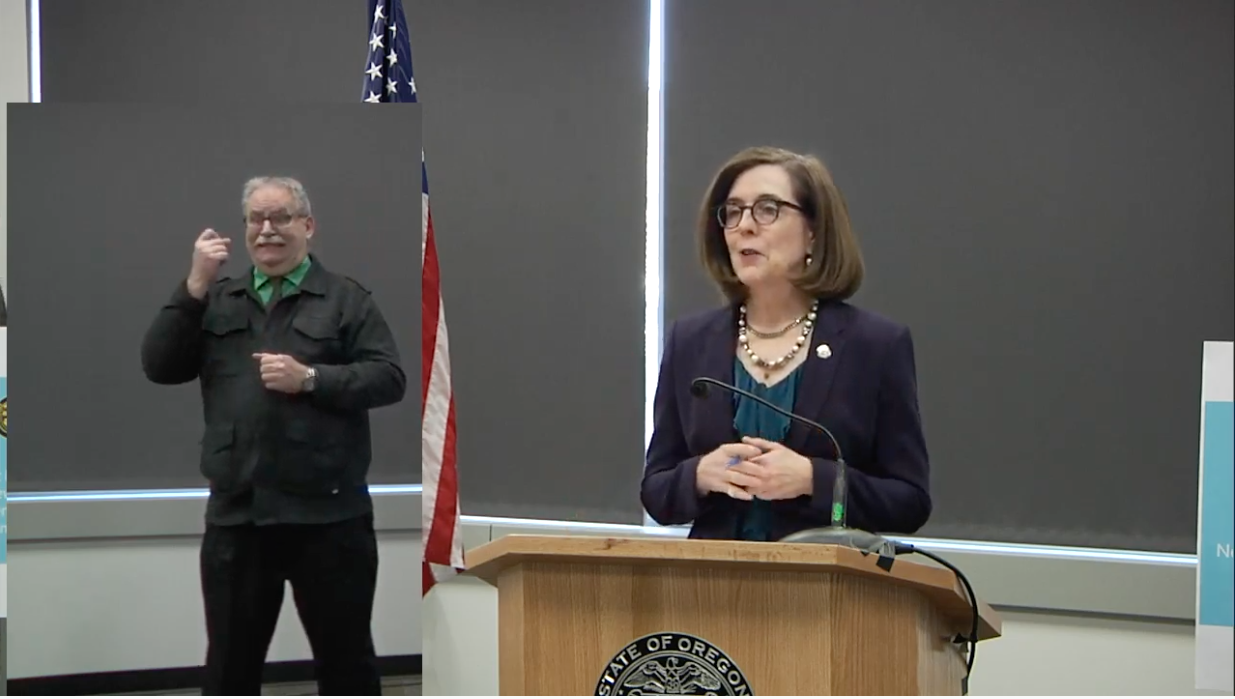At his so-called ratings record-breaking busting press conference April 13, President Donald Trump claimed “total authority” over states. But on that same day, governors from California, Washington and Oregon said they would open economies in concert. In her typically understated way, Gov. Kate Brown defied Trump, while not actually admitting to defying Trump.
Brown held a press conference Tuesday to discuss the plan further, saying the state needs to meet certain requirements before reopening. But despite a willingness to have a united front with other West Coast states, we’re already seeing a bit of difference when it comes to releasing adults in custody.
“In the early days of this pandemic, I had to take swift action,” she said at the April 14 press conference. “As we see these efforts are working to flatten the curve, we’re analyzing how and when to reopen each part of our society and our economy.”
Although Trump has created a committee to investigate when to open the U.S — filled with people like his son-in-law and daughter — Brown said Oregon’s framework is based on science and facts. She said she wants to see fewer cases of COVID-19 that are specified by experts. If the state moves forward too fast, it could result in a spike of cases, hospitalization and unnecessary deaths, she said.
“The best path forward is a cautious one,” she added.
Before the state opens up, Brown says she wants to see a slowdown of COVID-19 cases. Although the state is conducting about 8,000 tests a day, Oregon needs nearly 15,000 a week. The state also needs more personal protective equipment (PPE) to protect health care workers and to be in a position where a delay in shipment won’t result in a stop in all nonessential surgeries as it did to the state a few weeks ago.
Dr. Dean Sidelinger, the state’s health officer, said at the press conference that the state is learning about statewide hospital PPE usage.
But he added that the metric to reopen depends on whether the state is flattening the cases, decreased hospitalizations and not seeing the beginning of a surge in cases.
The state needs ramped-up testing capabilities to identify where the virus is. Oregon also needs a better system to identify those who have been exposed to the virus, Brown said. She added Oregon also needs a quarantine procedure for senior living spaces and for the unhoused.
Reopening the state “will take longer than we want,” she said.
On how the state will reopen, Brown said business owners will meet with public health officials to talk about safety precautions. This could include wearing PPE or having a plexiglass divider between customers and employees.
She said that Oregon will work with California and Washington to see that business practices are adopted throughout the three states.
But Oregon has already differentiated itself from Washington in one key way. On Monday, April 13, Gov. Jay Inslee said he would release nearly 1,000 adults in custody. California has also released inmates. Brown, however, repeated today that she would not release any adults in custody in state institutions. She even said that Oregon’s state prison population is producing 3,000 to 4,000 cloth masks a day. People in the cramped close quarters of jails and prisons face increased risk from the coronavirus.
At the press conference, Brown remained cautious when asked what she thought about Trump’s comment on being in control. Instead, she said the reality of COVID-19 is that we all have to work together.
She did say that the state is in dire need of financial assistance. Oregon can’t have a deficit, and by shuttering the economy, the state has lost a lot of revenue. The problem with the $1 trillion CARES Act money is that it can’t be used to backfill money the state has already spent to combat COVID-19. Some of Oregon’s agencies have enacted a hiring freeze, but others have hired a lot of employees recently — like the Oregon Department of Employment, which hired several hundred people to process the daily 8,000 unemployment claims that come in.
But Brown said that she is just one of many governors frustrated with the inability to spend CARES Act money to backfill the budget.
Brown ended her introductory remarks with the thought that after the Great Recession, rural Oregon and people of color were among those who never benefited from the recovery.
“Today many of our heroes are low-income workers, in grocery stores, nursing aides and truck drivers,” she said. “But many more from cooks to dishwashers have lost their jobs. In many of these sectors, these jobs are held by people of color and women. Our efforts at reopening Oregon and addressing this virus must reflect this reality.”
This article has been updated to reflect a number of tests that need to be done weekly, not daily.
